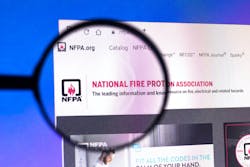NEC Article 502 Summary
Article 502 provides the requirements for Class II hazardous locations. These are locations (buildings, areas within buildings, or areas outside of buildings) where combustible dust is present or may be present. If it is (or may be) present under normal conditions, the location is Division 1. If it is (or may be) present under abnormal conditions, the location is Division 2. The requirements for Division 1 are more stringent than those for Division 2 because the risk is greater.
If this sounds a lot like a Class I area except we’re talking about dust instead of gas, that’s because (as Article 500 tells us) dust rather than gas is the difference. Dust particles are far larger than gas molecules, so dust is easier to contain and exclude than gas. This fact means the requirement for Class II are not as stringent as they are for Class I.
Boxes and fittings used in Class II locations need to be dust-tight; that’s the only requirement [502.10(B)(4)].
Sealing and drainage requirements for Class II locations [502.15] are minimal in contrast to the extensive requirements of Class I locations. There are no drainage methods. The 2020 NEC allowed four sealing methods, while the 2023 NEC adds a fifth: electrical sealing putty. And sealing is required only where a raceway provides communication between an enclosure that is required to be dust-ignition proof and one that is not.
Any installation should be bonded per Part I and Part V of Art. 250. For Class II locations, this is echoed in 502.30(B) just as it is in 501.30(B) for Class I locations.
As with Article 501, Article 502 goes on to provide specific requirements, and those echo what you find in Article 501.
Part III of Art. 502 contains specific requirements for equipment such as generators, luminaires, receptacles, transformers, capacitors, meters, and motors. But these are not the same as the Art. 501 requirements. For example, “No transformer or capacitor shall be installed in a Class II, Division 1, Group E Location” [502.100(A)(3)] has no counterpart in Art. 501. That’s because Group E is for metal dusts. Not only are dusts capable of extensive mechanical damage due to their hardness, but if you have a dust such as magnesium, you also have a fire hazard on your hands.
Metal dusts are a maintenance nightmare, especially something highly conductive such as aluminum dust. They scratch paint and other sealants such as the varnish on the windings of motors, generators, and transformers.
Metal dusts require additional attention to personal protective equipment. You should use a rubber mask with canister rather than a standard dust mask because getting that metal into your lungs is likely to result in pulmonary scar tissue (also known as pulmonary fibrosis). If extensive enough, it will make the victim spend his last few months gasping for every breath and feeling like he’s drowning. The metal gets in, and is not readily expectorated back out. It tends to stays in there, repeatedly cutting lung tissue.
